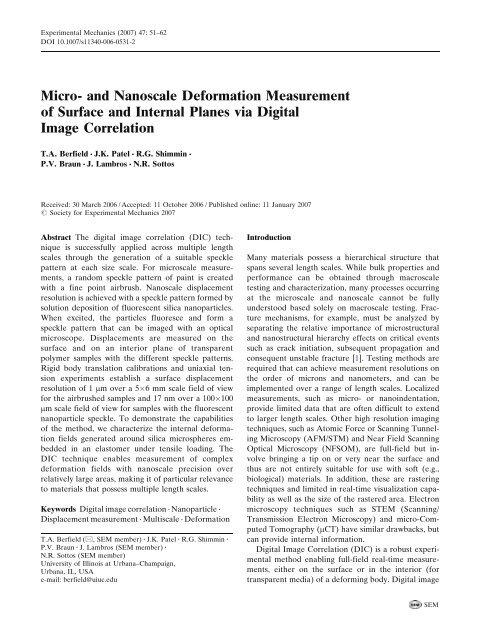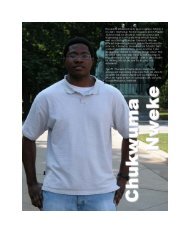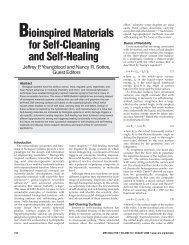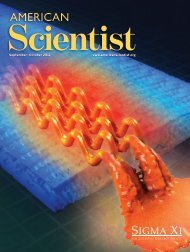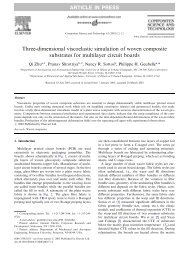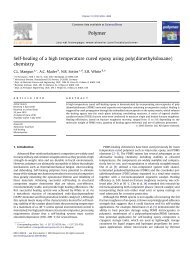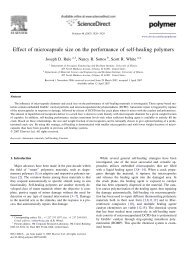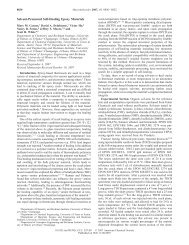Micro- and Nanoscale Deformation Measurement of Surface and ...
Micro- and Nanoscale Deformation Measurement of Surface and ...
Micro- and Nanoscale Deformation Measurement of Surface and ...
Create successful ePaper yourself
Turn your PDF publications into a flip-book with our unique Google optimized e-Paper software.
Experimental Mechanics (2007) 47: 51–62<br />
DOI 10.1007/s11340-006-0531-2<br />
<strong>Micro</strong>- <strong>and</strong> <strong>Nanoscale</strong> <strong>Deformation</strong> <strong>Measurement</strong><br />
<strong>of</strong> <strong>Surface</strong> <strong>and</strong> Internal Planes via Digital<br />
Image Correlation<br />
T.A. Berfield & J.K. Patel & R.G. Shimmin &<br />
P.V. Braun & J. Lambros & N.R. Sottos<br />
Received: 30 March 2006 /Accepted: 11 October 2006 / Published online: 11 January 2007<br />
# Society for Experimental Mechanics 2007<br />
Abstract The digital image correlation (DIC) technique<br />
is successfully applied across multiple length<br />
scales through the generation <strong>of</strong> a suitable speckle<br />
pattern at each size scale. For microscale measurements,<br />
a r<strong>and</strong>om speckle pattern <strong>of</strong> paint is created<br />
with a fine point airbrush. <strong>Nanoscale</strong> displacement<br />
resolution is achieved with a speckle pattern formed by<br />
solution deposition <strong>of</strong> fluorescent silica nanoparticles.<br />
When excited, the particles fluoresce <strong>and</strong> form a<br />
speckle pattern that can be imaged with an optical<br />
microscope. Displacements are measured on the<br />
surface <strong>and</strong> on an interior plane <strong>of</strong> transparent<br />
polymer samples with the different speckle patterns.<br />
Rigid body translation calibrations <strong>and</strong> uniaxial tension<br />
experiments establish a surface displacement<br />
resolution <strong>of</strong> 1 mm over a 56 mm scale field <strong>of</strong> view<br />
for the airbrushed samples <strong>and</strong> 17 nm over a 100100<br />
mm scale field <strong>of</strong> view for samples with the fluorescent<br />
nanoparticle speckle. To demonstrate the capabilities<br />
<strong>of</strong> the method, we characterize the internal deformation<br />
fields generated around silica microspheres embedded<br />
in an elastomer under tensile loading. The<br />
DIC technique enables measurement <strong>of</strong> complex<br />
deformation fields with nanoscale precision over<br />
relatively large areas, making it <strong>of</strong> particular relevance<br />
to materials that possess multiple length scales.<br />
Keywords Digital image correlation . Nanoparticle .<br />
Displacement measurement . Multiscale . <strong>Deformation</strong><br />
T.A. Berfield (*, SEM member) : J.K. Patel : R.G. Shimmin :<br />
P.V. Braun : J. Lambros (SEM member) :<br />
N.R. Sottos (SEM member)<br />
University <strong>of</strong> Illinois at Urbana–Champaign,<br />
Urbana, IL, USA<br />
e-mail: berfield@uiuc.edu<br />
Introduction<br />
Many materials possess a hierarchical structure that<br />
spans several length scales. While bulk properties <strong>and</strong><br />
performance can be obtained through macroscale<br />
testing <strong>and</strong> characterization, many processes occurring<br />
at the microscale <strong>and</strong> nanoscale cannot be fully<br />
understood based solely on macroscale testing. Fracture<br />
mechanisms, for example, must be analyzed by<br />
separating the relative importance <strong>of</strong> microstructural<br />
<strong>and</strong> nanostructural hierarchy effects on critical events<br />
such as crack initiation, subsequent propagation <strong>and</strong><br />
consequent unstable fracture [1]. Testing methods are<br />
required that can achieve measurement resolutions on<br />
the order <strong>of</strong> microns <strong>and</strong> nanometers, <strong>and</strong> can be<br />
implemented over a range <strong>of</strong> length scales. Localized<br />
measurements, such as micro- or nanoindentation,<br />
provide limited data that are <strong>of</strong>ten difficult to extend<br />
to larger length scales. Other high resolution imaging<br />
techniques, such as Atomic Force or Scanning Tunneling<br />
<strong>Micro</strong>scopy (AFM/STM) <strong>and</strong> Near Field Scanning<br />
Optical <strong>Micro</strong>scopy (NFSOM), are full-field but involve<br />
bringing a tip on or very near the surface <strong>and</strong><br />
thus are not entirely suitable for use with s<strong>of</strong>t (e.g.,<br />
biological) materials. In addition, these are rastering<br />
techniques <strong>and</strong> limited in real-time visualization capability<br />
as well as the size <strong>of</strong> the rastered area. Electron<br />
microscopy techniques such as STEM (Scanning/<br />
Transmission Electron <strong>Micro</strong>scopy) <strong>and</strong> micro-Computed<br />
Tomography (mCT) have similar drawbacks, but<br />
can provide internal information.<br />
Digital Image Correlation (DIC) is a robust experimental<br />
method enabling full-field real-time measurements,<br />
either on the surface or in the interior (for<br />
transparent media) <strong>of</strong> a deforming body. Digital image<br />
SEM
52 Exp Mech (2007) 47: 51–62<br />
correlation is a computer-based process to obtain two<br />
dimensional full-field displacement information by<br />
recording the motion <strong>of</strong> a speckle pattern on a specimen<br />
surface (Fig. 1) before <strong>and</strong> after deformation [2–5].<br />
Assuming a locally homogeneous deformation over a<br />
small subset <strong>of</strong> the specimen, the deformed coordinates<br />
(x q , y q ) <strong>of</strong> a material point q in the neighborhood<br />
<strong>of</strong> a point p, at undeformed location (x p , y p ), are<br />
given by<br />
x 0 q ¼ x q þ u p þ @u p<br />
@ x<br />
y 0 q ¼ y q þ v p þ @v p<br />
@ y<br />
Dx q þ @u p<br />
@ y<br />
Dy q ;<br />
Dy q þ @v p<br />
@ x<br />
Dx q ; ð1Þ<br />
where u p <strong>and</strong> v p are the x <strong>and</strong> y components <strong>of</strong> the<br />
displacement vector <strong>of</strong> point p, respectively, x q <strong>and</strong> y q<br />
are the undeformed coordinates <strong>of</strong> point q, Dx q ¼<br />
x q x p <strong>and</strong> Dy q ¼ y q y p .<br />
The displacement <strong>of</strong> a point p is found by either<br />
minimizing a least-square correlation coefficient, or<br />
maximizing a cross-correlation coefficient, <strong>of</strong> the<br />
grayscale intensity value before <strong>and</strong> after deformation,<br />
over a small locally homogeneous square subset S<br />
centered around p [4]. Since the grayscale intensity <strong>of</strong><br />
a point is assumed to be invariant with deformation,<br />
the correlation depends on the original position <strong>of</strong><br />
point p <strong>and</strong> the parameters describing its deformation,<br />
i.e., vector ! <br />
<br />
V ¼ u; v; @u<br />
@x ; @v<br />
@y ; @u @v<br />
@y<br />
; <strong>and</strong><br />
@x<br />
, the unknown<br />
deformation. Changes introduced to the grayscale<br />
intensity <strong>of</strong> the pattern, such as fluctuations <strong>of</strong> the<br />
light source, will affect the accuracy <strong>of</strong> the correlation.<br />
During the minimization process to find the unknown<br />
vector ! V , interpolation between pixels produces subpixel<br />
accuracy in the correlated displacement field <strong>of</strong><br />
about one-tenth <strong>of</strong> a pixel [6]. The interpolation errors<br />
associated with the correlation minimization scheme<br />
will also influence the measurement accuracy.<br />
DIC is an attractive technique for use over multiple<br />
length scales since the method does not possess an<br />
inherent length scale. The accuracy <strong>of</strong> the correlation<br />
between recorded images depends upon the quality <strong>of</strong><br />
the image speckle pattern <strong>and</strong> the resolution <strong>of</strong> the<br />
imaging system. Physical units <strong>of</strong> displacement are<br />
obtained by multiplying the pixel-based measurements<br />
<strong>of</strong> DIC by the image resolution in pixels/unit length.<br />
The ability to perform digital image correlations on a<br />
particular pattern is highly dependent on the refinement,<br />
distribution, <strong>and</strong> r<strong>and</strong>omness <strong>of</strong> the speckle<br />
relative to the pixel size in the image, as well as the<br />
dimensions <strong>of</strong> the subset used in the correlation. While<br />
there are no well-defined guidelines on the optimization<br />
<strong>of</strong> the imaged speckle size relative to the pixel<br />
Fig. 1 Speckle patterns tailored for the specific magnification<br />
required. (a) A pattern created by a low-quality airbrush (Badger<br />
250), (b) a pattern created by a higher-quality airbrush (Iwata<br />
Custom <strong>Micro</strong>n B) <strong>and</strong> (c) a pattern created by fluorescent<br />
nanoparticle surface deposition are shown at similar magnifications<br />
size, a pattern can be qualitatively described by the<br />
image intensity pr<strong>of</strong>ile, where the number <strong>of</strong> pixels at a<br />
given grayscale intensity value ranging from 0 to 255 is<br />
plotted against that intensity value. Unacceptable<br />
SEM
Exp Mech (2007) 47: 51–62 53<br />
patterns, i.e. ones that will not correlate with accurate<br />
results, produce a bimodal distribution, Fig. 2(a), with<br />
dominant peaks at either end <strong>of</strong> the grayscale spectrum<br />
[7]. Patterns more appropriate to image correlation<br />
have been observed to possess either a Gaussian<br />
or bell-shaped distribution, Fig. 2(b) <strong>and</strong> (c).<br />
DIC has been successfully coupled with optical<br />
microscopy in the past to obtain full-field surface<br />
displacement measurements with microscale accuracy.<br />
Gonzalez <strong>and</strong> Knauss [8] proved the feasibility <strong>of</strong> the<br />
technique <strong>and</strong> Abanto-Bueno <strong>and</strong> Lambros [9] extended<br />
the method to real-time measurements while<br />
imaging craze development in polyethylene. Digital<br />
image correlation is also suitable for nanoscale measurements<br />
when coupled with imaging techniques such<br />
as STM <strong>and</strong> AFM. Vendroux et al. [10] used DIC with<br />
an STM to investigate the fiber/matrix interphase<br />
response in polymer matrix composites. Chasiotis <strong>and</strong><br />
Knauss [6] successfully combined DIC with AFM<br />
imaging to measure the elastic properties <strong>of</strong> polysilicon.<br />
The AFM/DIC set-up <strong>of</strong> Chasiotis <strong>and</strong> Knauss [6]<br />
had a resolution <strong>of</strong> ca. 5 nm displacement, over a 10<br />
mm field <strong>of</strong> view. However, unlike microscale DIC<br />
experiments where paint was used to obtain a surface<br />
speckle pattern, in the nanoscale studies the speckle<br />
pattern is dependent on the surface roughness pr<strong>of</strong>ile<br />
<strong>of</strong> the sample material.<br />
In this paper, we discuss the application <strong>of</strong> DIC for<br />
full-field real-time measurements both at the micro<strong>and</strong><br />
the nanoscale, performed on either the patterned<br />
surface or an interior plane (for transparent media) <strong>of</strong><br />
a deforming body. An optical microscope is used as the<br />
imaging device, thus considerably simplifying the<br />
experimental set-up over that requiring an AFM/<br />
STM. An important aspect <strong>of</strong> this work is the<br />
generation <strong>of</strong> a suitable speckle pattern for use with<br />
DIC at each size scale (Fig. 1). The same DIC<br />
correlation algorithm is used with macro-, micro- or<br />
nanoscale resolution if the specimen surface coating<br />
technique is modified such that a correlatable pattern<br />
is obtained in each case. Lower resolution DIC<br />
measurements employ a simple method such as spray<br />
painting to generate a surface pattern for DIC at<br />
image resolutions only as low as 10 mm/pixel [9, 11].<br />
Figure 1(a) shows a magnified view <strong>of</strong> a pattern that is<br />
unsuitable for DIC at the scale shown. For the<br />
microscale experiments in the current work, a fine<br />
point airbrush is used to generate a speckle pattern<br />
[Fig. 1(b)], while for nanoscale experiments fluorescent<br />
nanoparticle tracers are employed [Fig. 1(c)] [12].<br />
Rigid body translation <strong>and</strong> uniaxial tension experiments<br />
are carried out separately to establish the<br />
displacement resolutions at each scale. For this work,<br />
the scope <strong>of</strong> the experiments is limited to small strains<br />
in isotropic elastomers.<br />
Specimen Preparation<br />
Transparent polymer samples were prepared with DIC<br />
patterns at two different size scales for displacement<br />
measurements on the surface [Fig. 3(a)] <strong>and</strong> on an<br />
internal plane [Fig. 3(b)]. Table 1 summarizes the<br />
details <strong>of</strong> sample preparation, the patterning technique<br />
<strong>and</strong> image acquisition for each sample type as described<br />
below.<br />
Fig. 2 Pixel intensity histograms for the patterns presented in Fig. 1: (a) coarse paint pattern made with the Badger airbrush which<br />
provides poor correlations, <strong>and</strong> acceptable DIC patterns created using (b) an Iwata fine-nozzle airbrush, <strong>and</strong> (c) the deposition <strong>of</strong><br />
nanoparticles<br />
SEM
54 Exp Mech (2007) 47: 51–62<br />
Fig. 3 Schematic representation<br />
<strong>of</strong> (a) surface patterned,<br />
<strong>and</strong> (b) internally patterned<br />
samples prepared for digital<br />
image correlation<br />
<strong>Micro</strong>scale Airbrush DIC Pattern<br />
<strong>Surface</strong> pattern<br />
Following the method outlined in Patel, [13] speckle<br />
patterns suitable for DIC at image resolutions ranging<br />
from 3 to 10 mm/pixel were applied to sheets <strong>of</strong> a<br />
polyethylene–carbon monoxide (ECO) copolymer<br />
(ITW-HiCone, Inc.) using an Iwata Custom <strong>Micro</strong>n B<br />
airbrush. The nozzle diameter <strong>of</strong> this airbrush is 0.18<br />
mm which allows for greater paint diffusion resulting<br />
in smaller paint droplets (speckles) than those in<br />
Abanto-Bueno <strong>and</strong> Lambros [9, 11]. In addition, its<br />
gravity-feed system when coupled with a lighter weight<br />
drawing ink provided excellent consistency. Air was<br />
provided by a constant 100 psi pressure regulated<br />
compressed air system. When viewed under a microscope<br />
as shown in Fig. 1(b), the new pattern produces<br />
an image with similar characteristics to images previously<br />
known to have worked with DIC.<br />
Internal pattern<br />
For internal measurements, a transparent silicone<br />
rubber (GE Silicones, RTV-615) was chosen to enable<br />
optical imaging through the thickness <strong>of</strong> the sample.<br />
Specimens were prepared through a two step process.<br />
Initially, one polymer layer was cast into a multipart<br />
mold to a thickness <strong>of</strong> approximately 1.5 mm <strong>and</strong><br />
allowed to cure partially at room temperature for 24 h.<br />
While the exposed surface was still tacky because <strong>of</strong><br />
partial curing, a speckle pattern was sprayed on it<br />
using the method described above. After allowing the<br />
ink to dry for a few minutes, a second layer <strong>of</strong> silicone<br />
rubber, also 1.5 mm thick, was poured onto the first.<br />
The entire casting was then left for a few days to cure<br />
completely, after which time the specimens were<br />
removed from the mold <strong>and</strong> cut to final dimensions.<br />
The resulting internal speckle pattern was similar to<br />
the surface one shown in Fig. 1(b).<br />
A second set <strong>of</strong> microscale airbrush patterned<br />
samples were made in a similar manner, with the<br />
additional step <strong>of</strong> adding a dilute concentration <strong>of</strong><br />
silica glass microspheres (with radii r ¼ 70 80 mm)<br />
on top <strong>of</strong> the patterned bottom layer. After deposition<br />
<strong>of</strong> the top layer, the resulting specimen had internally<br />
embedded spheres with a patterned plane located just<br />
below it at z=jr (for z=0 at the sphere midplane). The<br />
patterned layer <strong>and</strong> embedded microspheres were<br />
situated the same as with the other samples, halfway<br />
through the sample thickness [Fig. 3(b)]. Polydimethylsiloxane<br />
(PDMS) was substituted as the matrix<br />
material in this case for meaningful comparisons with<br />
nanoparticle patterned samples.<br />
Table 1 Sample material, preparation details, <strong>and</strong> imaging conditions for each <strong>of</strong> the patterning methods tested<br />
Patterning method Material Sample preparation Imaged resolution<br />
Airbrushed, <strong>Surface</strong> ECO as delivered, fully cured 102m/pixel<br />
Airbrushed, Internal<br />
Silicone Rubber,<br />
first layer: 24 h at 30-C<br />
3.02m/pixel<br />
GE Silicones<br />
second layer: 48 h at 30-C<br />
Nanoparticle, <strong>Surface</strong> PDMS 48 hours at 30- 134 nm/pixel<br />
Nanoparticle, Internal PDMS first layer–48 hours at 30-C;<br />
UV, oxygen plasma treated;<br />
second layer–48 hours at 30-C<br />
213 nm/pixel<br />
SEM
Exp Mech (2007) 47: 51–62 55<br />
Fluorescent Nanoparticle DIC Pattern<br />
<strong>Surface</strong> pattern<br />
For nanoscale measurements, the speckle pattern was<br />
created by excitation <strong>of</strong> fluorescent nanoparticles solution<br />
deposited onto the surface <strong>of</strong> a polymer sample. The<br />
nanoparticles were fabricated according to the synthesis<br />
procedure outlined by van Blaaderen <strong>and</strong> Vrij, [14] <strong>and</strong><br />
Verhaegh <strong>and</strong> van Blaaderen [15]. The silica nanospheres<br />
were labeled with rhodamine B isothiocyanate,<br />
with peak excitation frequency <strong>of</strong> 555 nm. To minimize<br />
potential photobleaching upon excitation, the fluorescent<br />
dye was incorporated at the nanoparticle core with<br />
a subsequently grown outer shell <strong>of</strong> silica. A mean<br />
particle diameter <strong>of</strong> 140–180 nm was determined by<br />
transmission electron microscope (TEM) images such<br />
as Fig. 4(a). By dispersing the nanoparticles in ethyl<br />
alcohol, a final colloidal suspension with a 3.0%<br />
concentration by mass was prepared for the purpose<br />
<strong>of</strong> spin coating.<br />
Samples were created by casting sheets <strong>of</strong> Sylgard<br />
184 (Dow Corning) polydimethylsiloxane (PDMS)<br />
prepared with a 10:1 ratio <strong>of</strong> resin to curing agent<br />
<strong>and</strong> a 48 h cure at 30-C. After curing, the sample<br />
surface was exposed to a 30 min ultraviolet (UV) box<br />
treatment to alter the surface chemistry <strong>and</strong> enhance<br />
adhesion with the silica nanoparticles. A colloidal<br />
suspension <strong>of</strong> fluorescent nanoparticles was then<br />
deposited onto the UV treated sample surface at<br />
1,250 rpm, resulting in a monodisperse layer <strong>of</strong> silica<br />
nanoparticles adhered to the PDMS substrate. The<br />
SEM micrograph in Fig. 4(b) reveals that the nanoparticles<br />
were well adhered <strong>and</strong> r<strong>and</strong>omly distributed<br />
across the sample surface. Upon appropriate light<br />
excitation under an optical microscope the nanoparticles<br />
fluoresce to a size approximately four to five<br />
times their diameter, thus producing a pattern suitable<br />
for image correlation, Fig. 1(c).<br />
Internal pattern<br />
Fig. 4 (a) Silica nanoparticles used for internal samples before<br />
deposition imaged using a TEM. (b) Dispersed nanoparticles on<br />
the PDMS sample surface after spincoating under an SEM<br />
Following nearly the same synthesis procedure detailed<br />
above, a second batch <strong>of</strong> fluorescent nanoparticles<br />
(ca. 140 nm) was produced. As before, the<br />
particles were dispersed in ethanol <strong>and</strong> diluted to a<br />
solution with 3.0% concentration by mass. Samples <strong>of</strong><br />
PDMS created for internal measurements were builtup<br />
using the same two layer approach used for the<br />
internally patterned microscale samples. Initially, the<br />
bottom half <strong>of</strong> each sample was poured <strong>and</strong> fully cured<br />
for 48 h at 30-C. Next, the samples were subjected to<br />
consecutive treatments in a UV box <strong>and</strong> an oxygen<br />
plasma device (March Plasmod). Immediately following<br />
the oxygen plasma treatment, nanoparticles were<br />
solution deposited on the surface at 1,250 rpm.<br />
Samples were subject to a brief heat treatment<br />
(100-C for 30 sec.) to strengthen bonding between<br />
the silica nanoparticles <strong>and</strong> the PDMS surface. The<br />
samples were then placed in a mold <strong>and</strong> an additional<br />
layer <strong>of</strong> PDMS was poured over the nanoparticlecoated<br />
surface. After the top layer cured for 48 h at<br />
30-C, the final sample contained an internal layer <strong>of</strong><br />
fluorescent nanoparticles embedded near the specimen<br />
midplane. Upon excitation, the nanoparticles produced<br />
a pattern similar to that <strong>of</strong> the surface coated<br />
specimens, Fig. 1(c).<br />
In analogy to the microscale case, an additional set <strong>of</strong><br />
internally nanoparticle patterned specimens were fabricated<br />
which included a sparse concentration <strong>of</strong> embedded<br />
silica glass microspheres with r ¼ 70 80 mm. The<br />
resulting samples had a fluorescent nanoparticle pat-<br />
SEM
56 Exp Mech (2007) 47: 51–62<br />
terned layer just below the embedded silica sphere in<br />
the plane z=jr, forz=0 at the sphere midplane.<br />
Experimental Procedure<br />
Specimen Imaging<br />
<strong>Micro</strong>scale surface patterned samples were imaged<br />
using an Olympus SZX-12 stereomicroscope <strong>and</strong> a<br />
640480 pixel Sony XC-77 monochrome CCD camera.<br />
The resolution <strong>of</strong> the imaged surface was 10 mm/pixel,<br />
producing a total field <strong>of</strong> view <strong>of</strong> 6.44.8 mm.<br />
Internally patterned samples were imaged using a<br />
zoom factor <strong>of</strong> 3.3, giving a resolution <strong>of</strong> 3 mm/pixel<br />
<strong>and</strong> a 1.91.4 mm field <strong>of</strong> view. Since both polymers<br />
used for microscale tests were completely transparent,<br />
a uniformly white background was positioned behind<br />
the specimens to provide contrast with the black paint<br />
speckles during testing. Nanoparticle coated specimens<br />
were imaged under a Leica DM-R fluorescent microscope<br />
(with Hg lamp excitation source) using a<br />
QImaging Retiga monochrome CCD camera with<br />
1,2801,024 pixel resolution. For surface coated specimens,<br />
a 50 long working distance objective lens with<br />
no camera relay lens was used, giving an image<br />
resolution <strong>of</strong> 134 nm/pixel <strong>and</strong> a total field <strong>of</strong> view <strong>of</strong><br />
roughly 170140 mm. Internally patterned samples<br />
were imaged slightly differently by adding a 0.63<br />
relay lens. This modified imaging set-up produced a<br />
resolution <strong>of</strong> 213 nm/pixel, with a total field <strong>of</strong> view<br />
roughly 270220 mm. <strong>Micro</strong>sphere embedded samples<br />
were imaged at a pixel resolution <strong>of</strong> 533 nm/pixel,<br />
which gives a pattern acceptable for correlation while<br />
allowing for a greater field <strong>of</strong> view. For all fluorescent<br />
nanoparticle patterns, the background was dark <strong>and</strong><br />
the spheres appeared white upon excitation when<br />
viewed with a black <strong>and</strong> white camera.<br />
Imaging conditions for the fluorescent nanoparticle<br />
coated specimens were adjusted to minimize any<br />
photobleaching <strong>of</strong> the fluorescent dye. If photobleaching<br />
induced variations in the emitted light intensity<br />
created significant changes in the imaged pattern, poor<br />
correlation <strong>and</strong> erroneous displacement measurements<br />
were observed. As expected, the intensity <strong>of</strong> the<br />
excitation light source significantly affected the rate<br />
<strong>of</strong> bleaching. For the surface patterned samples, the<br />
effect <strong>of</strong> excitation intensity on nanoparticle photobleaching<br />
was investigated by taking a series <strong>of</strong> timelapse<br />
images <strong>of</strong> undeformed patterned samples under<br />
different lighting conditions. As shown in Fig. 5, light<br />
sources near the dye excitation frequency resulted in<br />
significant declines in the measured mean image<br />
Fig. 5 Mean intensity <strong>of</strong> nanoparticle patterned samples over<br />
time under excitation using a variety <strong>of</strong> illumination conditions<br />
intensity (labeled Bmax^ <strong>and</strong> Blow^). Greater stability<br />
in pixel intensity was obtained by lowering the<br />
intensity <strong>of</strong> the excitation light source <strong>and</strong> using<br />
auxiliary light sources at frequencies different from<br />
the peak excitation frequency <strong>of</strong> the fluorescent nanoparticles.<br />
For the internally embedded nanoparticle samples,<br />
a longer exposure time <strong>and</strong> less auxiliary light were<br />
necessary to produce images with the appropriate<br />
pattern contrast. These modifications did result in a<br />
slight increase in photobleaching rate compared to the<br />
surface patterned specimens. However, correlations<br />
performed on time-lapse images <strong>of</strong> undeformed specimens<br />
showed that photobleaching had no noticeable<br />
effect on the pattern quality or DIC measurements for<br />
the time scales associated with the testing in this work.<br />
Baseline Tests<br />
Noise levels associated with room vibrations, temperature<br />
fluctuations, etc., were determined by performing<br />
baseline tests in which no deformations was<br />
applied. Tests on both the surface <strong>and</strong> internally<br />
patterned microscale airbrushed samples showed an<br />
average r<strong>and</strong>om noise level <strong>of</strong> T0.5 mm (0.05 pixels).<br />
Conversely, baseline tests performed on the samples<br />
surface coated with nanoparticles displayed an average<br />
T7 nm (0.05 pixels) measured noise level in either<br />
direction, while the samples internally patterned with<br />
nanoparticles had an average <strong>of</strong> T18 nm (0.08 pixels)<br />
SEM
Exp Mech (2007) 47: 51–62 57<br />
measured noise. Additionally, image variations introduced<br />
by refocusing on the patterned plane were<br />
measured by comparing images <strong>of</strong> an undeformed<br />
pattern taken before <strong>and</strong> after refocusing on the same<br />
plane. For the nanoparticle coated samples, the<br />
pattern layer provided a particularly distinct focal<br />
plane which helped ensure that the same image plane<br />
was found. The variations in displacement upon<br />
refocusing were indistinguishable from the baseline<br />
noise level for each pattern type.<br />
Rigid Body Translations<br />
For rigid body tests, samples were attached to a<br />
calibrated actuator stage <strong>and</strong> translated uniformly in<br />
one direction. For the airbrushed samples, rigid body<br />
translations over the range <strong>of</strong> 10 to 100 mm were<br />
applied using a computer-controlled servo motor with<br />
sub-micron precision (Polytec-PI, Model M-224.50) to<br />
drive an actuator stage. Translations for the nanoparticle<br />
samples were provided over a range from 10 to<br />
100 nm by applying a series <strong>of</strong> DC voltages to a<br />
piezostack actuator stage (Thor Labs, Model PE4).<br />
Tensile Tests<br />
Tensile testing <strong>of</strong> both the microscale airbrushed <strong>and</strong><br />
the nanoparticle coated specimens was performed<br />
using a DC-mike actuator (Polytec-PI, Model M-<br />
224.50) connected to a tensile grip. The other tensile<br />
grip was rigidly mounted to a support frame <strong>and</strong> did<br />
not move. Care was taken during the grip alignment to<br />
ensure that imaged plane <strong>of</strong> the sample remained flat<br />
for the course <strong>of</strong> the experiment. Samples for all tests<br />
were cut from patterned full sheets <strong>of</strong> the elastomer<br />
material to final dimensions <strong>of</strong> 8.0 mm wide by 30 mm<br />
long. The ends <strong>of</strong> the samples were fixed in the tensile<br />
grips, such that the initial distance between the grips<br />
was approximately 20 mm. All samples were then<br />
loaded quasi-statically <strong>and</strong> imaged under an optical<br />
microscope, with continuous image acquisition <strong>of</strong> the<br />
patterned area throughout the duration <strong>of</strong> the test.<br />
<strong>Micro</strong>scale airbrush <strong>and</strong> nanoparticle coated samples<br />
were tested at extensional rates <strong>of</strong> 1.0 <strong>and</strong> 0.1 mm/sec,<br />
respectively. Samples containing just the patterned<br />
layer were tested over a range <strong>of</strong> strains to determine<br />
system resolution capabilities, while a constant 3.5%<br />
strain was applied to specimens with embedded glass<br />
microspheres. Results <strong>of</strong> the tensile tests are provided<br />
in BResults^.<br />
Results<br />
Rigid Body Translations<br />
The displacements measured by DIC are compared<br />
with the applied translations in Fig. 6(a) for both<br />
surface <strong>and</strong> internal airbrush patterned samples. For<br />
each translation, the average displacement was calculated<br />
from the entire DIC produced vector field <strong>of</strong><br />
correlation points. The DIC measured displacements<br />
corresponded well with the translations applied from<br />
100 down to 1.0 mm for the surface patterned samples.<br />
Beyond this lower limit, there were marked increases<br />
in the st<strong>and</strong>ard deviation <strong>of</strong> measured displacement, as<br />
well as more variability in DIC vector field directionality.<br />
These limitations are expected as the size <strong>of</strong> the<br />
applied translations approaches the baseline noise<br />
level.<br />
The average DIC measured displacements for the<br />
internally patterned microscale specimens were con-<br />
Fig. 6 Comparison <strong>of</strong> internal<br />
<strong>and</strong> surface DIC measurements<br />
<strong>of</strong> rigid body<br />
translations versus the applied<br />
translation for (a) paint<br />
speckle pattern, <strong>and</strong> (b)<br />
nanoparticle speckle pattern<br />
SEM
58 Exp Mech (2007) 47: 51–62<br />
sistent with the applied translations across most <strong>of</strong> the<br />
range tested. However, the st<strong>and</strong>ard deviation <strong>of</strong> the<br />
displacement measurement across the DIC generated<br />
vector field was significant (greater than 5%) for<br />
applied translations below 20 mm. The increased error<br />
may be due in part to the change in index <strong>of</strong> refraction<br />
in the optical path. <strong>Surface</strong> patterned samples are<br />
imaged through air (n=1.003) only, while internally<br />
patterned samples are imaged through air <strong>and</strong> 1.5 mm<br />
<strong>of</strong> GE Silicones RTV-615 (n=1.406) or PMDS<br />
(n=1.41).<br />
For the nanoparticle patterned samples, the average<br />
displacement was once again calculated from the DIC<br />
generated vector field <strong>and</strong> plotted against the applied<br />
translation, Fig. 6(b)—note the difference in scale<br />
from Fig. 6(a). The error bars reflect the scatter<br />
observed in this measurement over three separate<br />
tests. For the surface patterned nanoparticle samples,<br />
DIC measurements <strong>of</strong> translations in the range from<br />
20–100 nm produced uniform vector fields with<br />
minimal variation in vector magnitude or direction<br />
<strong>and</strong> that were consistently within 15–20 nm <strong>of</strong> the<br />
applied translation. As the applied translations were<br />
reduced below 20 nm, there was a significant increase<br />
in the DIC vector field directionality scatter. This same<br />
increase in variability was observed to occur for<br />
applied translations below 40 nm for the internally<br />
patterned nanoparticle samples, Fig. 7. The lower limit<br />
<strong>of</strong> measurable translations in this case corresponds to<br />
approximately one-sixth to one-fifth <strong>of</strong> a pixel, compared<br />
with the previously mentioned one-tenth to oneeighth<br />
pixel.<br />
The lower limit for the accuracy in DIC measurements<br />
<strong>of</strong> nanoscale displacements is directly related to<br />
the background noise level <strong>of</strong> the imaging set-up.<br />
Major contributors to the noise include thermal drift<br />
<strong>and</strong> set-up vibrations. The baseline tests made no<br />
separation <strong>of</strong> these contributions, <strong>and</strong> simply characterized<br />
the overall noise magnitude for each set <strong>of</strong><br />
patterns <strong>and</strong> imaging conditions. In general, the DIC<br />
displacement resolution limit for the internally patterned<br />
samples was slightly worse than the surface<br />
patterned samples, which may be attributed to the<br />
change in index <strong>of</strong> refraction in the optical path (air<br />
versus air plus 1.5 mm <strong>of</strong> PDMS). Additionally, the<br />
internal nanoparticle patterned samples showed a<br />
disproportionately higher noise level in the baseline<br />
tests compared to that measured for the surface<br />
nanoparticle patterned samples. This result was<br />
expected in accordance with the extended exposure<br />
time necessary for imaging the internally embedded<br />
fluorescent nanoparticle pattern (10 sec, as opposed to<br />
the 300 ms exposure for the surface nanosphere<br />
patterned specimens), which makes those measurements<br />
more susceptible to r<strong>and</strong>om noise disturbances.<br />
Despite the reduced resolution limit for the internal<br />
nanoparticle patterned samples, the DIC measured<br />
translations from 40–100 nm agreed well with the<br />
applied translations, consistently falling within 35 nm.<br />
Tensile Tests on Patterned Uniform Samples<br />
For all samples loaded in uniaxial tension, DIC<br />
measured contours <strong>of</strong> constant displacement were used<br />
to calculate the average strain across the field <strong>of</strong> view.<br />
The locally measured strain was then used to calculate<br />
the expected far-field displacement based on the initial<br />
gage length <strong>and</strong> the assumption <strong>of</strong> uniform sample<br />
deformation. The results for the microscale airbrushed<br />
samples, Fig. 8(a), <strong>and</strong> the nanoparticle coated specimens,<br />
Fig. 8(b), are plotted against the applied farfield<br />
displacement.<br />
For both the internal <strong>and</strong> surface airbrush patterned<br />
samples, local strains calculated from DIC contours <strong>of</strong><br />
Fig. 7 Vector plots <strong>of</strong> DIC measured translations on an internally nanoparticle patterned sample, where the applied displacement in<br />
the Bx^ direction is 16 nm (a), 40 nm (b), <strong>and</strong> 76 nm (c)<br />
SEM
Exp Mech (2007) 47: 51–62 59<br />
Fig. 8 Comparison <strong>of</strong> farfield<br />
tensile displacements,<br />
calculated from local DIC<br />
measurements on both internal<br />
<strong>and</strong> surface specimens,<br />
against the applied<br />
far-field displacement for (a)<br />
paint speckle patterned, <strong>and</strong><br />
(b) nanoparticle coated samples<br />
constant displacement were close to the actual applied<br />
far-field strains. In each case, the most deviation came<br />
at the highest applied strain level. Possible reasons for<br />
this discrepancy include issues associated with the<br />
sample grips (slipping, etc.) <strong>and</strong> the potential for a<br />
non-uniform strain fields due to sample barreling.<br />
Also, the largest applied deformations are getting<br />
away from the small strain regime to which this DIC<br />
method should be confined. In both types <strong>of</strong> microscale<br />
airbrush patterned samples, the closest distinguishable<br />
contours <strong>of</strong> constant displacement were<br />
typically 1–5 mm.<br />
DIC results from tensile tests on the surface coated<br />
nanoparticle samples revealed contours <strong>of</strong> constant<br />
displacement differing by only 20 nm, consistent with<br />
the measurement resolution limit found for rigid body<br />
translation tests. For the internally patterned samples,<br />
the DIC contour line threshold shown in Fig. 9 was<br />
roughly 35 nm. While the DIC results from the<br />
internally patterned samples had more noise in the<br />
contour lines for the smallest applied strain levels, farfield<br />
applied displacements were accurately measured.<br />
Tensile Tests on Embedded Inclusion Samples<br />
Airbrush samples with a dilute concentration <strong>of</strong><br />
internally embedded silica microspheres, with the<br />
same dimensions as Fig. 3(b), were loaded in uniaxial<br />
tension at a strain level <strong>of</strong> 3.5%. With the large depth<br />
<strong>of</strong> field for the low magnification used in imaging the<br />
internal airbrushed pattern, the location <strong>of</strong> a single<br />
microsphere could easily be determined when focusing<br />
Fig. 9 Contours <strong>of</strong> constant displacement for an internally<br />
embedded layer <strong>of</strong> fluorescent nanoparticles in a PDMS sample<br />
loaded in tension at an applied strain level <strong>of</strong> 0.37%<br />
Fig. 10 Rigid silica microsphere internally embedded at the<br />
midplane <strong>of</strong> a PDMS sample. An airbrush patterned layer,<br />
located at the bottom <strong>of</strong> the sphere, is used to determine the<br />
deformation field <strong>of</strong> that plane for an applied uniaxial tension<br />
SEM
60 Exp Mech (2007) 47: 51–62<br />
Fig. 11 <strong>Deformation</strong> fields<br />
showing Bu^ (a) <strong>and</strong> Bv^ (b)<br />
displacements near a silica<br />
microsphere (radius r=73 mm)<br />
internally embedded in a<br />
PDMS sample loaded in uniaxial<br />
tension (3.5% strain).<br />
For each displacement component,<br />
experimental DIC<br />
measurements for the airbrushed<br />
pattern are compared<br />
with the predicted<br />
analytical solution <strong>of</strong> a rigid<br />
spherical inclusion proposed<br />
by Goodier [16] for the plane<br />
z=r (where the z=0 for the<br />
sphere midplane)<br />
on the patterned layer below, as shown in Fig. 10.<br />
Experimental DIC measurements <strong>of</strong> the displacement<br />
field surrounding the microsphere were compared to<br />
the theoretically predicted field near a rigid inclusion<br />
(the z=jr plane, for z=0 at the sphere midplane) in an<br />
elastic infinite medium under a remote tensile stress as<br />
determined by Goodier [16]. The sparseness <strong>of</strong> the<br />
silica microsphere inclusions is such that we can<br />
effectively consider the microsphere isolated <strong>and</strong><br />
therefore make valid comparisons with the Goodier<br />
solution for a rigid sphere in an infinite elastic space.<br />
Furthermore, because <strong>of</strong> the large elastic property<br />
mismatch between PDMS <strong>and</strong> silica glass, the microsphere<br />
is considered rigid. Finally, at the small strains<br />
applied in the experiments the PDMS should behave<br />
in a linear elastic fashion. For the microscale pattern<br />
Fig. 12 Image focused on a<br />
fluorescently excited nanoparticle<br />
patterned layer,<br />
(a) located just below a rigid<br />
silica microsphere embedded<br />
within a PDMS sample. The<br />
exact location <strong>of</strong> the microsphere<br />
is determined by focusing<br />
at the sphere<br />
midplane under normal<br />
lighting conditions (b)<br />
SEM
Exp Mech (2007) 47: 51–62 61<br />
Fig. 13 <strong>Deformation</strong> fields<br />
showing Bu^ (a) <strong>and</strong> Bv^ (b)<br />
displacements near a silica<br />
microsphere (radius r=78 mm)<br />
internally embedded in a<br />
PDMS loaded in uniaxial<br />
tension (3.5% strain). Experimental<br />
results via DIC<br />
measurements on the internal<br />
nanoparticle pattern are<br />
shown with the predicted analytical<br />
solution [16] for the<br />
plane z=r (where the z=0 for<br />
the sphere midplane)<br />
case, contours <strong>of</strong> Bu^ displacement in the loading<br />
direction, are shown in Fig. 11(a). The far-field strain<br />
was in good agreement to the actual applied strain.<br />
Closer to the sphere, however, the DIC measurements<br />
showed increased variability <strong>and</strong> deviations from the<br />
analytical solution. The difference in the local theoretical<br />
<strong>and</strong> experimental displacement fields was even<br />
greater for the contours <strong>of</strong> Bv^ displacement, shown in<br />
Fig. 11(b). The increased variability is expected for the<br />
much smaller deformations measured in this direction.<br />
A sample with a similarly sized silica microsphere<br />
embedded just above an internal fluorescent nanoparticle<br />
pattern layer [Fig. 12(a) <strong>and</strong> (b)] was also<br />
loaded to a far-field strain level <strong>of</strong> 3.5%. The DIC Bu^<br />
contours <strong>of</strong> displacement [Fig. 13(a)] showed much<br />
less variation from the theoretical predictions than the<br />
airbrush pattern, especially very close to the microsphere.<br />
The Bv^ contours found from DIC measurements<br />
[Fig. 13(b)] were much closer to the theoretical<br />
field for the nanoparticle pattern than those found for<br />
its counterpart internal airbrush patterned sample<br />
under the same loading. The airbrush pattern was not<br />
refined enough to discern the intricacies <strong>of</strong> the displacement<br />
field on this size-scale. On the other h<strong>and</strong>,<br />
the nanoparticle speckle pattern enables measurement<br />
<strong>of</strong> an accurate deformation field across a highly<br />
localized field <strong>of</strong> view through higher magnification<br />
<strong>and</strong> spatial resolution. Optimization <strong>of</strong> the imaging<br />
parameters with this method should allow for deformation<br />
field measurements surrounding nanoscale inclusions,<br />
while the extension <strong>of</strong> this technique to capture<br />
full-field deformations on an internal sample plane<br />
lends itself to possible 3D volumetric measurements<br />
similar those made in confocal techniques.<br />
Conclusion<br />
We have demonstrated the feasibility <strong>of</strong> the DIC<br />
technique to image planar deformations at both the<br />
SEM
62 Exp Mech (2007) 47: 51–62<br />
microscale <strong>and</strong> the nanoscale using a simple set-up<br />
based on optical microscopy. Successful application <strong>of</strong><br />
DIC at the different length scales relied on the ability<br />
to generate a speckle pattern at the scale under<br />
consideration. The microscale pattern was generated<br />
using a fine point airbrush to deposit paint on the<br />
specimen surface. The nanoscale pattern was produced<br />
by solution deposition <strong>of</strong> a monodisperse layer <strong>of</strong><br />
fluorescent rhodamine dye infused silica nanoparticles<br />
(140–180 nm in diameter) on the specimen surface.<br />
When excited appropriately, the nanoparticles fluoresced<br />
to a size scale several times their diameter <strong>and</strong><br />
generated a pattern that can be imaged in an optical<br />
microscope <strong>and</strong> used for DIC. The use <strong>of</strong> fluorescent<br />
nanoparticles was a significant development in that the<br />
particles allow for nanoscale displacement detection<br />
while minimally disturbing the structure under interrogation.<br />
Rigid body translation <strong>and</strong> uniaxial tensile<br />
testing were used to investigate the lower limits <strong>of</strong><br />
measurement accuracy at each length scale. Suitable<br />
patterns were generated for testing at the microscale<br />
with measurement resolution <strong>of</strong> 1 mm, <strong>and</strong> the nanoscale<br />
with a resolution <strong>of</strong> resolution <strong>of</strong> 17 nm. Finally,<br />
the technique was extended to making similar internal<br />
microscale <strong>and</strong> nanoscale measurements in a deforming<br />
transparent polymer with an embedded speckle<br />
pattern at its midplane. A comparison <strong>of</strong> DIC measured<br />
deformation fields surrounding a micron-scale<br />
rigid inclusion for both nanoparticle <strong>and</strong> airbrush<br />
internally patterned samples loaded in uniaxial tension<br />
provided an example <strong>of</strong> the relative accuracy <strong>and</strong><br />
operating size-scale for the two patterning methods.<br />
Acknowledgments The authors would like to acknowledge the<br />
support <strong>of</strong> the AFOSR (MURI Award No. F49550-05-1-0346),<br />
the NSF (grant CMS 00-8206) <strong>and</strong> the U.S. Department <strong>of</strong><br />
Enegy, Division <strong>of</strong> Materials Sciences (Award No. DEFG02-<br />
91ER45439), through the Federick Seitz Materials Research<br />
Laboratory at the University <strong>of</strong> Illinois at Urbana–Champaign.<br />
Additionally, R.G.S. acknowledges fellowship support from the<br />
Fannie <strong>and</strong> John Hertz Foundation.<br />
References<br />
1. Nalla RK, Kinney JH, Ritchie RO (2003) Mechanistic<br />
fracture criteria for the failure <strong>of</strong> human cortical bone. Nat<br />
Mater 2(3):164–168.<br />
2. Peters WH, Ranson WF (1982) Digital imaging techniques in<br />
experimental stress analysis. Opt Eng 21(3):427–431.<br />
3. Sutton MA, Wolters WJ, Peters WH, Ranson WF, McNeill<br />
SR (1983) Determination <strong>of</strong> displacements using an improved<br />
digital image correlation method. Image Vis Comput<br />
1(3):133–139.<br />
4. Peters WH, Ranson WF, Sutton MA, Chu TC, Anderson J<br />
(1983) Application <strong>of</strong> digital correlation methods to rigid<br />
body mechanics. Opt Eng 22(6):738–742.<br />
5. Chu TC, Ranson WF, Sutton MA, Peters WH (1985)<br />
Applications <strong>of</strong> digital-image-correlation techniques to experimental<br />
mechanics. Exp Mech 25(3):232–244.<br />
6. Chasiotis I, Knauss WG (2002) A new microtensile tester for<br />
the study <strong>of</strong> MEMS materials with the aid <strong>of</strong> atomic force<br />
microscopy. Exp Mech 42(1):51–57.<br />
7. Schreier HW, Braasch JR, Sutton MA (2000) Systematic<br />
errors in digital image correlation caused by intensity<br />
interpolation. Opt Eng 39(11):2915–2921.<br />
8. Gonzalez J, Knauss WG (1998) Strain inhomogeneity <strong>and</strong><br />
discontinuous crack growth in a particulate composite. J<br />
Mech Phys Solids 46(10):1981–1995.<br />
9. Abanto-Bueno J, Lambros J (2005) Experimental determination<br />
<strong>of</strong> cohesive failure properties <strong>of</strong> a photodegradable<br />
copolymer. Exp Mech 45(2):144–152.<br />
10. Vendroux G, Schmidt N, Knauss WG (1998) Submicron<br />
deformation field measurements: part 3. demonstration <strong>of</strong><br />
deformation determinations. Exp Mech 38(3):154–160.<br />
11. Abanto-Bueno J, Lambros J (2004) Mechanical <strong>and</strong> fracture<br />
behavior <strong>of</strong> an artificially ultraviolet-irradiated poly(ethylene-carbon<br />
monoxide) copolymer. J Appl Polym Sci<br />
92(1):139–148.<br />
12. Berfield TA, Patel JK, Shimmin RG, Braun PV, Lambros J,<br />
Sottos NR (2006) Fluorescent image correlation for nanoscale<br />
deformation measurements. Small 2(5):631.<br />
13. Patel JK (2003) Digital image correlation for microscale <strong>and</strong><br />
nanoscale deformation measurement. M.S. Thesis, University<br />
<strong>of</strong> Illinois at Urbana–Champaign.<br />
14. van Blaaderen A, Vrij A (1992) Synthesis <strong>and</strong> characterization<br />
<strong>of</strong> colloidal dispersions <strong>of</strong> fluorescent, monodisperse<br />
silica spheres. Langmuir 8(12):2921–2931.<br />
15. Verhaegh NAM, van Blaaderen A (1994) Dispersions <strong>of</strong><br />
rhodamine-labeled silica spheres. synthesis, characterization,<br />
<strong>and</strong> fluorescence confocal scanning laser microscopy. Langmuir<br />
10(5):1427–1438.<br />
16. Goodier JN (1933) Concentration <strong>of</strong> stress around spherical<br />
<strong>and</strong> cylindrical inclusions <strong>and</strong> flaws. Appl Mech 1(2):39.<br />
SEM


